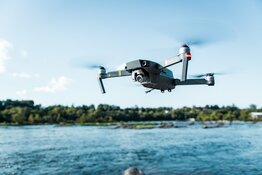DroneShield Ltd. (DRO:ASX; DRSHF:OTC), the Australian‑based defence technology company specialising in counter‑unmanned aircraft systems (C‑UAS) hardware and software, has delivered a strong update on its operational progress this year, while also disclosing recent insider share sales that have attracted investor attention.
For the full year of 2024, DroneShield reported revenue of approximately AU$57 million. According to its investor materials, the company has already secured committed revenue for 2025 of about AU$193.1 million, indicating more than triple the prior year's figure. The company's quarterly slides show revenue for the three months ending September 30, 2025, of AU$92.9 million (approximately AU$60 million), which the company describes as a "record quarter." In addition, the firm announced a single contract backlog of AU$61.6 million (approximately AU$40 million) from European military customers, representing the largest order in its history and exceeding the full‑year 2024 revenue. These figures reflect accelerating demand for DroneShield's offerings across military and civilian defence markets.
The company's product suite spans handheld, vehicle‑mounted, and fixed‑site counter‑drone systems that integrate radio‑frequency sensing, artificial‑intelligence‑driven software, sensor fusion, and effectors designed to detect, track, identify, and defeat drone threats under military standards. With growing global focus on drone threats, DroneShield says it is scaling up its manufacturing footprint, increasing inventory, and expanding its service‑based software revenue component.
DroneShield also disclosed that chief executive officer Oleg Vornik, chairman Peter James, and director Jethro Marks recently sold shares following the vesting of performance options. The company stated that these options were part of a long-term incentive plan and vested after DroneShield surpassed A$200 million in rolling cash receipts, a new company record.
The company stated: "The sales are 'unrelated to the growth trajectory of the company, which remains strong, as highlighted in the recent quarterly market update reflecting record quarter‑on‑quarter revenue growth and positive operating cashflow.'" While insider exits often raise investor questions, in this case, the firm emphasises that the divestitures were not linked to underlying performance. A broker report from the company's house broker, Bell Potter Securities, noted the sale but reiterated confidence in the company's expanding order‑book and revenue progress.
Operationally, DroneShield continues to highlight its strong momentum. The European order alone underscores the company's move from early‑stage evaluation contracts to larger-scale procurement. Its year‑to‑date committed revenue for 2025 already surpasses the full prior‑year figure, and its backlog and pipeline expansion suggest further growth potential in defence procurement cycles. At the same time, the company is reporting positive operating cash flow for the quarter, marking a transition point in its financial performance.
Counter-Drone Industry Shifts Toward Rapid Response and Scalable Innovation
According to a November 11 article from Defense News, the U.S. Army certified a new operational team tasked with rapidly responding to drone incursions on domestic military bases. The certification followed field tests in Florida and North Dakota, where the Army's Counter-small Unmanned Aerial System (UAS) fly-away kit team successfully neutralized over 100 aerial targets. General Gregory Guillot, commander of U.S. Northern Command and NORAD, stated, "The validation and certification of our Counter-small UAS fly-away kit is an important step in being able to support installation commanders within the United States as they defend against drone incursions."
The fly-away kit included multiple sensor-and-defeat technologies integrated into a single package, offering both kinetic and non-kinetic response options. The layered system featured electromagnetic warfare capabilities, thermal optics, radar, and a self-guided interceptor drone. The Department of Defense emphasized that the deployment marked a shift from advisory roles to active defensive capabilities against drone threats.
On November 14, Austin Bohlig of Needham & Co. commented on recent activity in the broader drone and counter-drone industry. He wrote that "the drone space has broadly sold off over the last four weeks, driven by the government shutdown and risk-off sentiment," but added that "following solid earnings across the board and upbeat 2026 demand commentary, we believe the unmanned supercycle is fully intact."
In a November 18 interview with Business Insider, Matt McCrann, then-CEO of DroneShield's U.S. division, noted that traditional defense technology development cycles were no longer sufficient for counter-drone needs. "Development cycles are weeks now, not months or years," he said. He explained that there was "very much a counter-counter fight going on," and emphasized the need for modular, software-first systems that can adapt rapidly to changing threats.
McCrann also observed that "we definitely have to expand our thinking as far as the potential threats and how we guard against them." He stated that Western awareness of drone vulnerabilities was growing and that existing defenses were often inadequate. His comments reflected broader concern across NATO and Western defense leaders, who have cited lessons from the Ukraine conflict as evidence that drone technology iterates far faster than traditional weapons systems.
Overall, these developments pointed to a shift in how governments and military organizations view the threat posed by small and medium-sized drones. The emphasis has shifted toward faster innovation cycles, adaptable systems, and integrated sensor platforms capable of detecting, tracking, and neutralizing drones across various environments.
Analyst Insights Highlight Advances in Counter-Drone Technology
According to an October 1 report from Shaw and Partners, analysts offered a buy rating for DroneShield. They examined developments in the counter‑drone sector, focusing on the growing role of artificial‑intelligence‑enabled surveillance and detection systems. Analyst Abraham Akra described one widely used AI platform in the market as "best in class," noting that its artificial intelligence tools reduced operator workload and accelerated detection speeds. He wrote that the combination of passive radio frequency sensing and AI supported more scalable and cost‑efficient deployments, particularly in mobile environments. Akra also discussed how recent regional defense initiatives, including proposals for multilateral drone defense networks in Eastern Europe, had increased attention on adaptable counter‑drone technologies.
In a November 3 research note published by Bell Potter Securities, analyst Baxter Kirk reiterated his Buy rating on DroneShield and reviewed recent sector activity, highlighting the continued expansion of AI‑driven counter‑drone solutions. According to the report, one defense customer in Latin America awarded a AU$25.3 million contract for advanced counter‑drone equipment. Kirk stated, "We believe [there is] the market‑leading counter‑drone offering and a strengthening competitive advantage owing to its years of experience and large R&D team, focused on detection and defeat capabilities." He also commented on broader industry dynamics, citing increased attention from governments on soft‑kill counter‑drone systems that disable threats without explosives or kinetic methods.
Expansion into Civilian Infrastructure and Scalable Production
According to the October 2025 Investor Presentation, the company introduced a subscription-based product called SentryCiv, designed for deployment in civilian infrastructure such as airports. The system was developed as a software-led offering and delivered through a software-as-a-service (SaaS) model. Company materials stated that SentryCiv was intended to be cashflow positive from launch and represented a key component of efforts to increase participation in non-military markets.
SaaS revenue for the third quarter increased by 400% year-over-year, according to company filings. Management noted growing interest in modular, software-based counter-UAS systems among government and infrastructure clients. The company reported that it had integrated multiple SaaS modules into its existing hardware products, including command-and-control software and optical identification systems.
The company also disclosed that it surpassed A$200 million in rolling cash receipts, a financial milestone that triggered the vesting of performance-based options under its long-term incentive plan. This development followed continued revenue momentum and was cited as a record in DroneShield’s corporate materials.
Streetwise Ownership Overview*
DroneShield Ltd. (DRO:ASX; DRSHF:OTC)
Manufacturing expansion plans were outlined in the same investor presentation. A new 3,000-square-meter facility in Sydney was under development, with additional production sites in Europe and the United States scheduled for later implementation. These facilities were planned to support increased global demand by scaling production capabilities.
Ownership and Share Structure1
Recent filings reveal that Vanguard Group has become a substantial shareholder in DroneShield, holding a 5.45% stake, Fidelity Management and Research holds approximately 7.49% and State Street Corporation holds approximately 5.35%.
Management and insiders hold 1.30%, according to the company.
DroneShield has 905.97 million outstanding shares and 863.8M free float traded shares. Its market cap is AU$2B. Its 52-week range is AU$0.58–AU$6.70 per share.
| Want to be the first to know about interesting Technology investment ideas? Sign up to receive the FREE Streetwise Reports' newsletter. | Subscribe |
Important Disclosures:
- As of the date of this article, officers and/or employees of Streetwise Reports LLC (including members of their household) own securities of Droneshield.
- James Guttman wrote this article for Streetwise Reports LLC and provides services to Streetwise Reports as an employee.
- This article does not constitute investment advice and is not a solicitation for any investment. Streetwise Reports does not render general or specific investment advice and the information on Streetwise Reports should not be considered a recommendation to buy or sell any security. Each reader is encouraged to consult with his or her personal financial adviser and perform their own comprehensive investment research. By opening this page, each reader accepts and agrees to Streetwise Reports' terms of use and full legal disclaimer. Streetwise Reports does not endorse or recommend the business, products, services or securities of any company.
For additional disclosures, please click here.
1. Ownership and Share Structure Information
The information listed above was updated on the date this article was published and was compiled from information from the company and various other data providers.










































